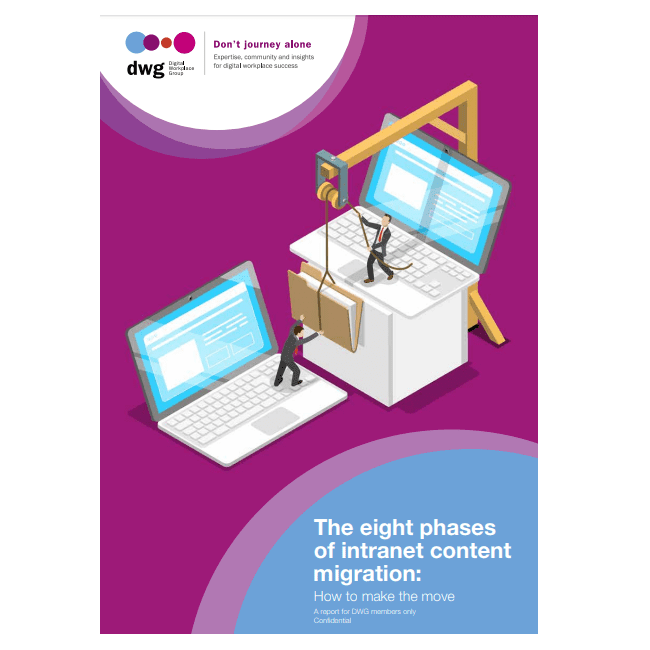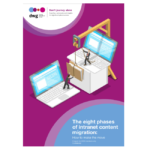The eight phases of content migration
 Have you been tasked with dealing with the content on an intranet that is tired, full of outdated pages and documents, and no longer fit for purpose?
Have you been tasked with dealing with the content on an intranet that is tired, full of outdated pages and documents, and no longer fit for purpose?
Has a new platform been procured, which is clean, fresh and full of the potential to provide a great experience for your colleagues, and where they can find current, accurate information on the topics they need to do their jobs with ease and efficiency?
If so, you will need a plan to realize this promise. DWG’s new research report “The eight phases of intranet content migration: How to make the move” covers the steps teams need to follow when migrating content from an old to a new platform, ensuring solid foundations for a successful intranet, with longevity and a strong user experience.
Many migration projects cut corners, perhaps through lack of resources, knowledge or the will to grapple with unwieldy, numerous and outdated pieces of content, however this can cause issues further down the line. The report outlines a model workflow for how to deliver intranet content migration in a project over eight phases:
- Scope: The benefits of having a clearly defined scope include the management of priorities and resources for both the intranet team and content owners. What does the “intranet” include and will this all be part of the migration?
- Engagement: Whatever the drivers, a range of stakeholders will need to play a part in order for the migration to be successful. How do you keep them supportive and informed?
- Analysis: Analysing the data you hold about your intranet can help you to: understand the ways employees are using the intranet; show which departments have the most content to manage; and identify ways to reduce the volume of content held through archiving or deletion. How do you conduct this analysis to give you the data and evidence you need?
- User needs: User need should be the focus of all the content on the site. Is the intranet making users’ lives simpler? Can people find information easily? How do you establish the needs of those using your site?
- Planning: Mapping out the structure of the new site, deciding where the content will live and what will be migrated first is best done at an early stage and tested with users before you launch your site. What are the current best practices for site structure and navigation?
- Content development: Intranet content should be mainly task based. The text giving the task information should be short, to the point and easy to read. But how do you get to this point when your current content is so wordy and out of date?
- Beta testing and launch: A beta phase, with the new site open to as many employees as possible, can be beneficial to test the information architecture and the usability of migrated or new content. How do you get this phase agreed by management so that you can realize these benefits?
- Business as usual: As the project closes, there is a risk that the board or senior managers will move onto other projects and the focus will shift. How do you retain this focus and buy-in long enough to allow the intranet to bed in and thrive?
Non-members can download the report excerpt, which includes a handy intranet content migration checklist. Download your copy now!
Get access to the full report and 70+ other best practice digital workplace reports
DWG members have access to this full report, which answers these questions and more with a detailed dive into each of the eight phases. It also includes two detailed case studies from Standard Life Aberdeen and Scottish Natural Heritage.
This report forms part of DWG’s best practice Research Library of 70+ reports covering key areas such as strategy and governance, personalization, user experience and change management for intranets and digital workplaces. Find out what else is in the library and new research that’s coming up. Contact us to learn how to gain access to this library via DWG membership.
Take the next step…
Categorised in: Content management, Research reports

